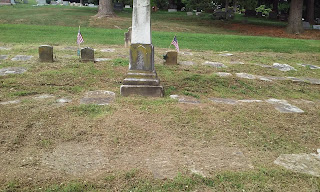Originally published on genealogyatheart.blogspot.com on 21 Aug 2016.
Last time I wrote about my meeting with the Cemetery Director on a recent research trip I took. His records did not direct me to the grave stone I was seeking but gave me an area in which to look. That was due to the re-internments of the stones from an older cemetery, Union, that had been exhumed when the land was sold.
I drove by the building that housed the re-internments. I thought it was a large shed to contain the tools to maintain the cemetery. Hmm. Nothing noted it to be a mass grave.
When the road started turning I knew I had somehow passed where I needed to be so I turned around and looked again. I parked and decided I might do better on foot. Very quickly I saw the older stones laying flat on the ground.
The grass had recently been cut and the stones were covered with debris. Having flown and then taken a rental car, I did not have my cemetery tools with me. It was about 8:45 AM and already starting to get hot. I hated to get all dirty and then have to be in that condition the rest of the day as I had two historical museums and a return trip to the library. It looked like rain so I decided to go for it.
Let’s give a cheer for fast food! I returned to the car and grabbed a knapkin I had from the Dunkin Donut stop earlier that morning. This is what I was dealing with:
Underneath all that brown stuff in the picture was tombstones. One lone Dunkin Donut knapkin and a bunch of dirty tombstones from the early to mid 1800’s. Oh, joy!
After taking the pic, I started at the bottom right hand corner and walked hunched over using the knapkin as a fan to blow the grass and dirt off the flat stones. It didn’t work very well but I kept at it.
By the time I got to the 3rd row (that’s the one the tall stone is in) and the 6th from the right (not visible above), I had found my man! There was Bart Bear’s stone (not his real name) in far worse condition than when it was first photographed for Find-A-Grave. To the immediate right was a smaller marble stone that was completely unreadable. It sort of looked like there had been a lamb shape in the center at one point but maybe it was just my mind trying to make sense of the senseless. I had assumed that per the cemetery and church records, that this stone listed as “Unknown” would have been Bart’s maternal grandfather’s marker as the church records stated they were buried next to each other. These were the only two stones that were made of the same marble but why the grandfather’s stone would have been so small didn’t make sense to me. Perhaps this was the marker for Bart’s missing sister, Barbara, who had not been recorded in church or cemetery records. She had also been missed in census records having died between census years. The only reason I knew of her was that one of her siblings had given her name to a family member who had written a genealogy of the family years later.
I cleaned the two stones the best I could and verified that the stone to the left was not a family member. It, too, was difficult to read and I wasn’t sure at first. After taking pictures, I then walked quickly through the remaining stones using the same fanning technique but with the knapkin a mess at this point. I found nothing else.
I stopped back at the cemetery office to let the Director know I much I appreciated his help. I guess I looked disarrayed as he asked if the stones were clean. I told him they were not and had tried to blow off the grass and dirt with a knapkin. He shook his head and told me the people who maintained the cemetery were not responsible workers and he would report them to their parole officer. Yikes! Wish he had warned me before I was out there alone wandering around. Would I have done something differently? Probably would have kept my phone in my hand and not in my pocket. Please keep this in mind when you’re out stone hunting. I’ll soon write about some other unsafe really dumb things I did on this trip that I would not do again (well, I probably would but I shouldn’t)- stay tuned!










